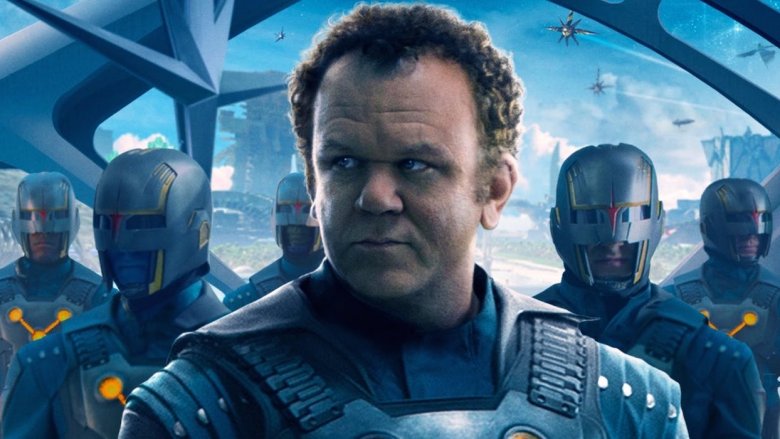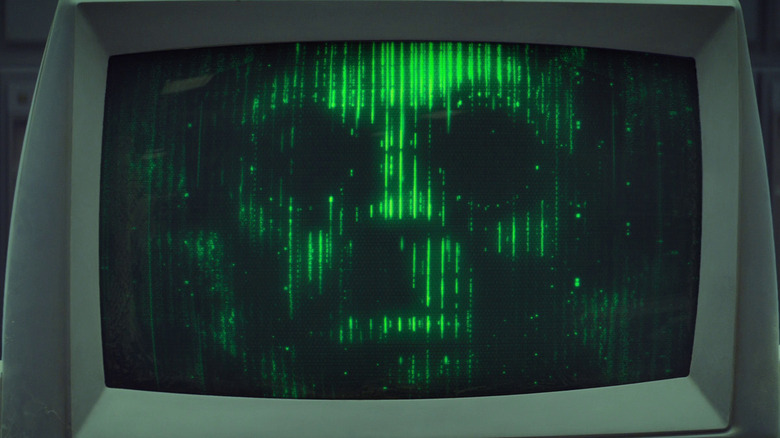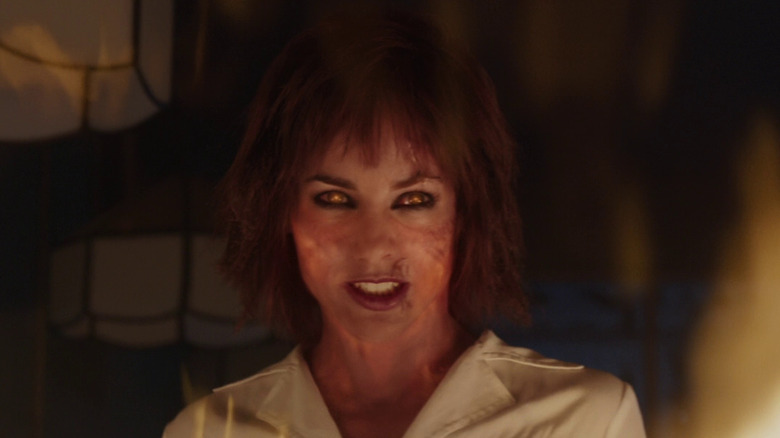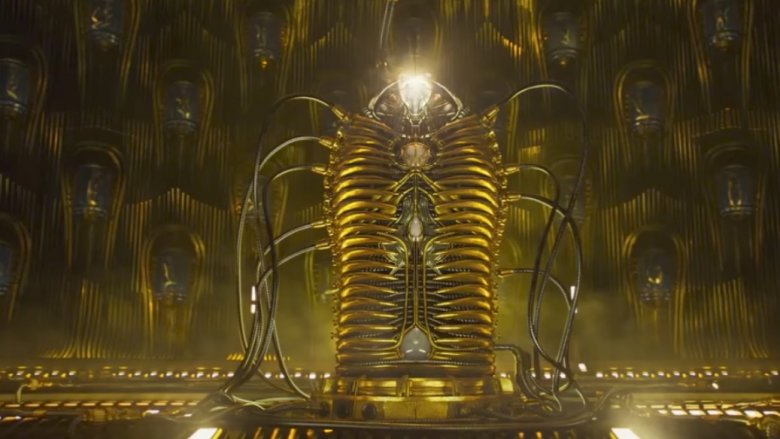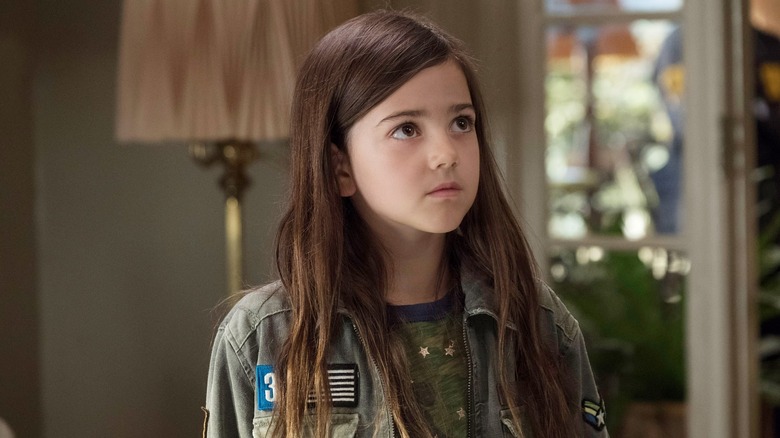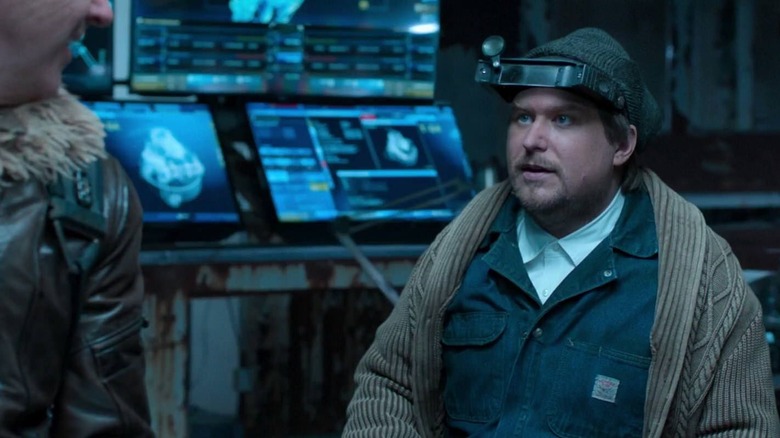Marvel Movie Characters Who Mean More Than You Realized
With 17 films so far and no sign of slowing down for the foreseeable future, the Marvel movies have created a sprawling cinematic universe populated with dozens of characters drawn from the comics—and they're not just limited to the big-name superheroes, either. From supporting cast members to mysterious adversaries and even references to alternate universes, the MCU is full of people who might mean a whole lot more than you realize.
So break out the Official Handbook and follow along as I lend my expertise to bring you the Marvel movie characters who mean a whole lot more than it seems.
Arnim Zola
Movie viewers may have been shocked when the evil scientist Arnim Zola, first seen alongside the Red Skull as one of Hydra's founding members during World War II, reappeared as a sentient computer in Captain America: The Winter Soldier. People who read the comics, however, were probably just surprised that his computer face wasn't mounted inside the torso of a robot.
Originally created in 1977 by Captain America's co-creator, Jack Kirby, Zola was known as the "Bio-Fanatic," a Nazi biochemist who attempted to create his own super-soldiers as an answer to Steve Rogers. Well after the war, he transferred his mind to a cybernetic body that displayed his face on a giant TV screen and took Cap on himself by creating monsters with names like Man-fish and Doughboy. Needless to say, that didn't quite work out, but he did manage to clone Adolf Hitler, creating a supervillain called the Hate-Monger, who once tried to destroy the world by blasting people with racism rays from outer space.
Admittedly, that seems like a pretty unlikely plot for the next Captain America movie—there are probably a few limits on how weird they're going to get, even if they do have two major movies starring a talking raccoon and his best friend, a tree—but the fact that Zola made a comeback as a computerized consciousness might mean they're not quite done with him yet. If he could do it once, who's to say that he couldn't do it again?
Ellen Brandt
In Iron Man 3, Tony Stark takes on an Extremis-powered agent of the Mandarin named Ellen Brandt in a fight that rages through Chattanooga and ends with her being blown through a wall by an exploding microwave. It's easy to miss her name if you're not paying attention, and honestly, even if you are, she's obscure enough that it might not register even if you do—especially because she's not actually an Iron Man character to begin with. Instead, she's actually tied to another Marvel hero: the Man-Thing.
She hit comics pages in Savage Tales #1 as an agent of AIM who turned on her lover, Ted Sallis. She shot him in the back and left him to die in a swamp, but thanks to an experimental serum he'd been working on, he rose from the depths as a shambling mound of vegetation whose touch would burn whoever knew fear, and who was tasked with guarding the Nexus of All Realities... which for some reason is in Florida. Also, you may know him best from his starring role in the comic that has everyone's favorite title, Giant-Size Man-Thing #1. Comics from the '70s are weird.
Anyway, the fact that Ellen is burned to a crisp in the middle of Tennessee might be the end of her story, but keep in mind that Marvel has actually tried to pull off a Man-Thing movie before, in the form of a low-budget SyFy original from 2005. With Doctor Strange in the mix, they might just be looking to add some more mystical elements to the MCU. Sure, Man-Thing would be a weird way to do it, but it's easy to imagine the Nexus of All Realities showing up on the big screen, if only for the comedy of Benedict Cumberbatch wading through the Everglades.
The Nova Corps
The Nova Corps actually plays a pretty big role in Guardians of the Galaxy, but we mostly see them acting as a massive interstellar peacekeeping force, without a lot of emphasis on individual members. On one hand, that makes sense—that movie already had five people/trees/forest creatures on the main team, plus two huge villains, plus the Collector, and the Corps is a pretty big deal in recent comics—but it does mean that we skip over the character who introduced us to the Corps to begin with: Richard Rider.
Created in 1976 by Marv Wolfman and John Buscema, Nova, a.k.a. the Human Rocket, was meant to be the Bronze Age's sci-fi answer to Spider-Man: a teenage hero who inherits the helmet and powers of a Centurion who dies on Earth—and if that sounds familiar, well, it's basically Green Lantern's origin, too. He'd bounce around the Marvel Universe for years, and while he was never a huge player, he was a big deal in Annihilation, the crossover that reintroduced the Star-Lord and the Guardians.
What really makes this interesting is that while Rider isn't in the movies, his predecessor, Rhommann Dey, is, played by John C. Reilly. Nova's also a founding member of the New Warriors, a team that's set to hit television screens sometime in 2018, and while he's not listed as part of the cast alongside Squirrel Girl and Night Thrasher, an appearance by the Nova Corps could certainly help tie it to Marvel's money-making movies.
Plus, c'mon. The guy's name is literally Dick Rider. There's no way the Guardians movies can resist throwing that one in there at some point, right?
The original Guardians of the Galaxy
While we're on the subject of teams that made unexpected appearances in the Guardians movies, there's one pretty cool homage to the comics that shows up in the post-credits sequence for Guardians of the Galaxy vol. 2, when Stakar Ogord (Sylvester Stallone) re-creates his own team of Ravagers. The reason this is a big deal, at least for fans of the comics? Well, while the modern team of Guardians has been built around Star-Lord, Rocket, Groot, Drax, and Gamora since 2006, they're not the first team to have that name—in this timeline, at least.
The original Guardians comics were set in the far-off future of the 31st century, featuring an entirely different roster of characters, and Stakar's pals at the end of the movie look awfully familiar. Ving Rhames plays the super-tough Charlie-27, Michael Rosenbaum is the crystalline Martinex, and Michelle Yeoh is Starhawk, a codename she shares with Stallone's character. We even get a quick look at Krugarr, the future Sorcerer Supreme, and Mainframe, an AI voiced in the movie by Miley Cyrus. Much like the movie, they were also on a team with Yondu, it just happened a thousand years in the future in the comics.
Whether that team will actually show up again is up in the air, but that sure is a cast loaded up with heavy hitters for what amounts to a deep-cut cameo.
Adam Warlock
Okay, one last one from Guardians, and this one's almost guaranteed to be a pretty big deal. All throughout the movie, the Guardians find themselves hunted by Ayesha, the High Priestess of the Sovereigns that they piss off in the opening scenes. Unable to get her revenge by the end of the film, Ayesha uses the Sovereigns' talent for genetic engineering to create the perfect instrument, and while we never see him, we know his name: Adam.
A genetically engineered perfect golden warrior named Adam? For fans of Marvel's cosmic side, there's no mystery about who that is: Adam Warlock, who dates back to Stan Lee and Jack Kirby's run on Fantastic Four. Originally known simply as "Him," he was revamped by Roy Thomas and Gil Kane as Adam Warlock, one of a surprising number of attempts by Marvel to create an outer-space messiah. He's even his own arch-nemesis, with a dark side known as the Magus who came back from the future to conquer the galaxy and his own past self.
As for why he's important, Adam's biggest role in the larger Marvel Universe has been as a keeper of one of the Infinity Stones, and one of the heroes who helped to defeat Thanos at the climax of Jim Starlin's Infinity Gauntlet. Considering that the MCU has been building to a conflict with Thanos for the past decade or so, and that the upcoming Infinity War movie is set to combine the earthbound Avengers with the spacefaring Guardians, there's a pretty big chance we're going to be seeing a lot of Adam Warlock in the future.
Cassie Lang
One of the weirder things about the Marvel movies is that while they show no sign of slowing down, the march of time is going to continue unabated. Another decade, and Robert Downey Jr., for instance, will be in his 60s, and the question of whether to re-cast Tony Stark or move forward with a different set of Marvel heroes will definitely be more pressing.
The thing is, though, the MCU may have already started introducing the next generation of Avengers. In Ant-Man, a huge part of the plot revolves around Scott Lang's struggle to find acceptance with his ex-wife and their daughter, Cassie. In the comics, however, Cassie isn't just Ant-Man's daughter—she's a superhero in her own right.
Currently known as Stinger—and previously operating alongside the Young Avengers under the codename Stature—Cassie inherited her dad's size-changing abilities, and was even seen in an alternate future roster of Avengers in the pages of A-Next. Sure, we're still a long way from seeing her take over the role herself, but given that the first Ant-Man movie put its hero in dire peril of being run over by Thomas the Tank Engine, a superheroic take on Honey, I Blew Up The Baby wouldn't exactly be out of character.
Aaron Davis
The scene in Spider-Man: Homecoming when Spidey interrogates a crook played by Donald Glover is one of the funniest pieces of the entire MCU, but the reason it's interesting goes well beyond just the chuckles of Peter Parker trying to act tough. See, Glover's character is actually Aaron Davis, and in Ultimate Marvel—an offshoot of the core universe that imagines an updated version of Peter who got his powers in the 21st Century and sported a truly terrible haircut—he's better known as the Prowler.
But that's just the tip of the iceberg. The real fun part comes when Glover mentions his nephew. In the comics, Davis's nephew is none other than Miles Morales, who took over the role of Spider-Man after the Ultimate Universe's version of Peter died. Currently, with the two universes combined into one, Miles and Peter are both operating as Spider-Man, albeit in different costumes, with Miles filling the role of exactly the kind of teenage hero you're seeing in the movies. He even has a best friend who bears more than a passing resemblance to the movie's take on Ned.
If that sounds a little complicated, well, that's comics, but the short version is that Glover's character indicates that a second Spider-Man already exists in the MCU—or at least his alter ego does.
The Tinkerer
One of the most amazing things about Spider-Man: Homecoming is that while it definitely keeps the focus on Peter's conflict with the Vulture, that thing is crammed with comics characters. Just on the villainous side, there's the Scorpion, two versions of the Shocker, and a guy who eventually becomes a good-guy version of Venom—in the comics, at least. One of the most interesting appearances, however, comes from Phineas Mason, better known to Spider-Fans as the Terrible Tinkerer.
Created by Stan Lee and Steve Ditko, the Tinkerer is one of Spider-Man's oldest villains, first appearing way back in 1963's Amazing Spider-Man #2. Much like he does in the movie, the Tinkerer has a gift for crafting super-powered equipment that's pretty useful when committing the kind of crimes that you need the power of a radioactive spider-bite to deal with. As a result, he's one of the few villains in the Marvel Universe who's usually dealt with indirectly—he's the guy who makes the stuff the bad guys use, and while he rarely uses it himself, he's provided equipment for Mysterio, the Black Cat, the Beetle, the Hobgoblin, Hammerhead, and a couple dozen others besides.
We've already seen a bit of that with the Shocker, but with Mac Gargan running around and clearly looking for a way to get revenge on Spider-Man, it seems pretty likely that the Tinkerer could show up again to outfit another set of foes for everyone's favorite web-slinger.
Anne Marie Hoag and Damage Control
One of the interesting things about the MCU is that unlike a lot of city-leveling blockbusters, we actually get to see the consequences of, say, dropping an interdimensional alien army led by a space god onto Manhattan. It leads to a lot of weird stuff floating around—and it also means that someone is tasked with cleaning it all up. As we see in Homecoming, that someone is Damage Control.
In the movies, they're a department of the government, but in the comics, the great Dwayne McDuffie and Ernie Colón introduced them as a private contracting firm. While the version we see in the movies is pretty serious, The approach in the comics had a strong comedic bent, working like a sitcom that hung a lampshade on the widespread destruction that comes with letting the Hulk loose in a major metropolitan area. They even employ superheroes like Hercules to get the job done quickly. So quickly, in fact, that it often happens off-panel.
One interesting quirk? While Anne Marie Hoag is the head of Damage Control in both the comics and the movies, her original funding came from an unlikely pair of allies: Tony Stark and Wilson Fisk, better known as the Kingpin, who both had an interest in seeing Manhattan patched up as quickly as possible. While the Kingpin's appearances in the MCU so far have been limited to the Netflix shows, which tend to stay pretty separate from their big-screen counterparts, that's certainly a connection that we could see somewhere down the road.
The Dora Milaje
Just judging by the cast, the Black Panther movie is drawing pretty heavily from Christopher Priest and J.G. Jones's take on the character from 1998—and if you're a comics reader, you already know that's a good thing. It's one of the most critically acclaimed runs of the '90s, and introduced a ton of great stuff to the Panther, including Everett Ross, the S.H.I.E.L.D. agent moviegoers first saw in Captain America: Civil War. But there's another pair of Priest and Jones creations that are way more exciting than Ross: the Dora Milaje.
Translated by Priest as "the adored ones," the Dora Milaje are women who act as representatives of different factions in Wakanda, with each one seen as a potential wife for the Black Panther. The trick, of course, is that if he never selects one, then each faction has no reason to scheme against the other as the result of a perceived slight, thus keeping the peace between rivals. Oh, and also that the Dora Milaje traditionally want to keep Wakanda's king alive long enough to settle down, meaning that they aren't just romantic interests—they're T'Challa's bodyguards, too.
If you're asking why a guy who can go toe-to-toe with Captain America needs bodyguards, consider that Ayo, Nakia, and Okoye are actually so badass that it make sense they can do the job.
